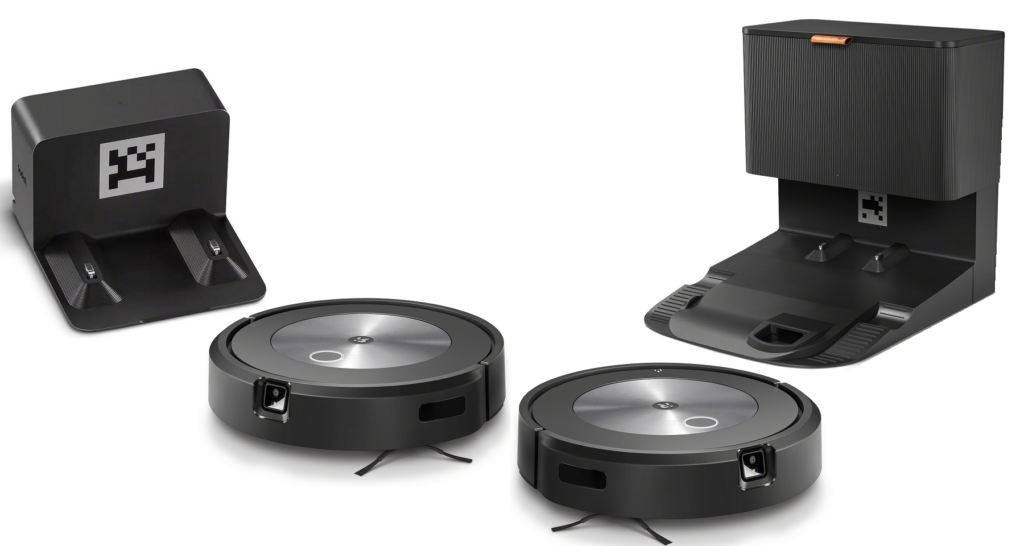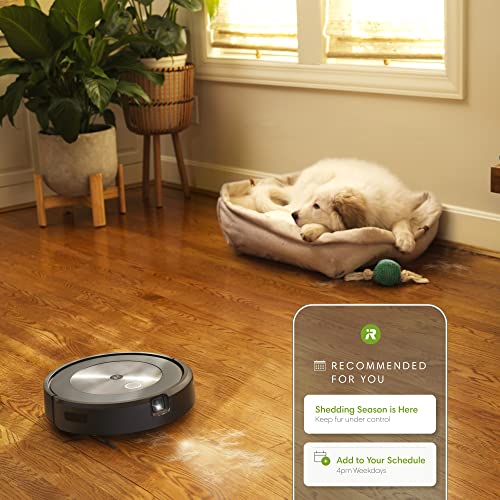In a nutshell, how does the Roomba j7 differ from the 7+?
The only difference between these two models is that the j7+ is auto-emptying, and the j7 is not. The robot vacuum units themselves are exactly the same, but the j7+ comes packaged with the auto-empty dock while the j7 comes packaged with a simple charging dock.
That was the short version. For the nitty-gritty details, continue reading below!
Contents
- 1 In a nutshell, how does the Roomba j7 differ from the 7+?
- 2 Similarities between the Roomba j7 and the Roomba j7+
- 2.1 Similarity 1: Both have object recognition and avoidance capabilities.
- 2.2 Similarity 2: Both models can create and save maps of your home.
- 2.3 Similarity 3: Both models clean in straight, tight lines.
- 2.4 Similarity 4: Both can automatically recharge, even halfway through a cleaning session.
- 2.5 Similarity 5: Both are controllable via app and voice assistant
- 2.6 Similarity 6: Both have “keep out zones” and “select room cleaning”.
- 2.7 Similarity 7: Both are equipped with dual rubber rollers.
- 2.8 Similarity 8: Both have geofencing so they can clean when you are not around.
- 3 FAQs
- 4 So, Which One Should You Choose?
Difference 1: The j7+ comes with the auto-empty dock, the j7 does not.
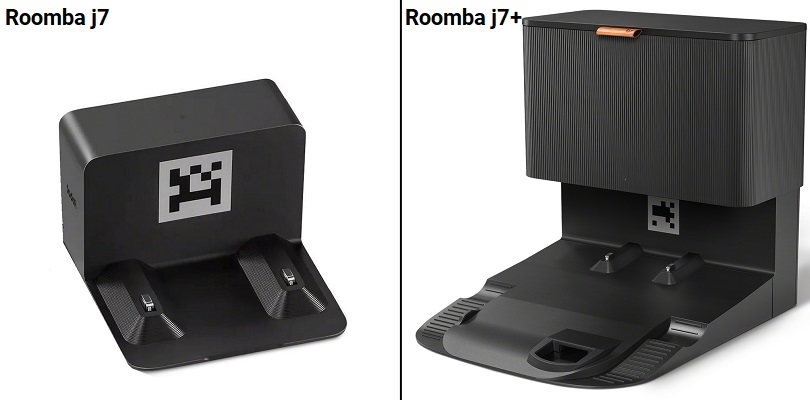
The j7+ comes packaged with the “Clean Base Automatic Dirt Disposal”, which is designed to recharge your robot vacuum as well as empty the vacuum’s dustbin after every cleaning session. Once the robot vacuum is done cleaning and returns to the base, the base will then automatically remove the contents of the dustbin.
The dock that comes with the j7 is for charging only, not auto-emptying. This means you need to empty the dustbin yourself. No big deal, it takes but a minute.
With the j7, you’ll ideally empty the dustbin after each cleaning session.
With the j7+, you’ll need to change the Clean Base’s dust bag every 2 months or so, depending on the size of your house and how much dirt it gets. With pet hair, the dust bag will fill up significantly faster.
Note that you can always get the j7 first, then choose to buy the auto-empty dock later if you come to realize that you need it. It’s a bit of a gamble because it costs a little bit more to buy the two separately.
If you know that you can’t do without auto-emptying, get the j7+ outright to save a little bit of money.
Or click here to see the Roomba j7+ on Amazon.
Similarities between the Roomba j7 and the Roomba j7+
Similarity 1: Both have object recognition and avoidance capabilities.
Since the j7 and j7+ robots themselves are the same, both will have the front-facing camera.
The camera enables them to recognize a variety of the objects that clutter floors: shoes, toys, cables, and the like. More importantly, they will recognize pet waste, which is very important if you have pets at home.
Knowing these objects are there will then let the navigation algorithm know to modify the vacuum’s route to avoid running into these objects. This way they can avoid sucking things like shoelaces or cables into the intake, which can cause damage.
If you have a pet that isn’t house-trained, the object recognition is tantamount in preventing a disaster. Robot vacuums without object recognition could make a mess even worse by spreading it over the entire floor.
iRobot’s database is constantly improving, so the list of objects that these robot vacuums can recognize and therefore avoid is also growing.
Or click here to see the Roomba j7+ on Amazon.
Similarity 2: Both models can create and save maps of your home.
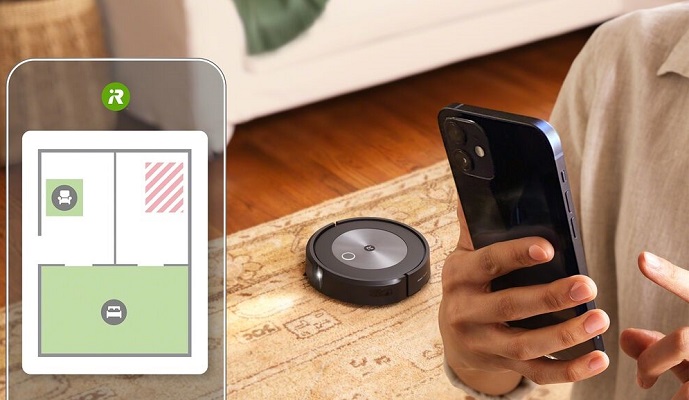
On their initial run, the j7 and j7+ will take their time to move around your home to learn its layout. They’ll then be able to create maps of your home, which you can then save under customized labels.
You can save up to 10 maps, enough for you to save maps for each level of your home, your sister’s apartment, your neighbor’s house, and perhaps even your uncle’s AirBNB.
Joking aside, these maps will allow you to customize cleaning sessions according to your preferences.
Similarity 3: Both models clean in straight, tight lines.
Rather than the typical random movement of older Roombas, both the j7 and j7+ clean in a logical path, like a human would.
This method of navigation is much more efficient, resulting in complete coverage of your floor in less time. It also makes sure the robot vacuum will clean around the edges of a room.
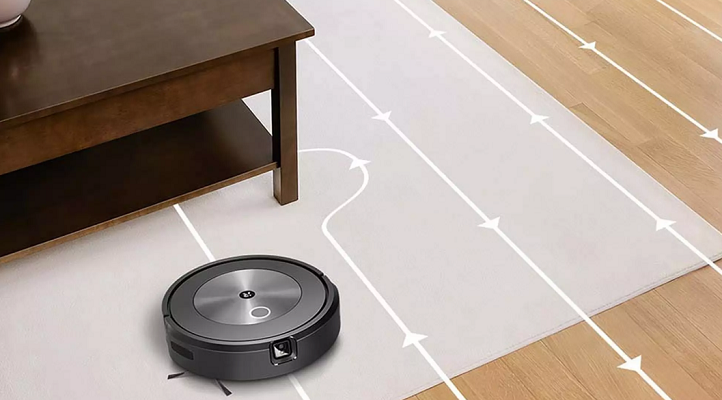
This makes these Roombas keep your floors clean as efficiently as possible.
Similarity 4: Both can automatically recharge, even halfway through a cleaning session.
The j7 and j7+ have a runtime of around 85 minutes, which can be too little or just enough depending on the size of your home.
However, even if they won’t be able to finish cleaning your home on a single full charge, they can automatically recharge so they can keep cleaning until they complete their cleaning session.
When the Roomba j7 or j7+ notices they won’t have enough juice to finish a cleaning session, they’ll pause the cleaning session, return to base to recharge, then resume cleaning where they left off.
This means the entire floor will be vacuumed, no matter how large it is.
Similarity 5: Both are controllable via app and voice assistant
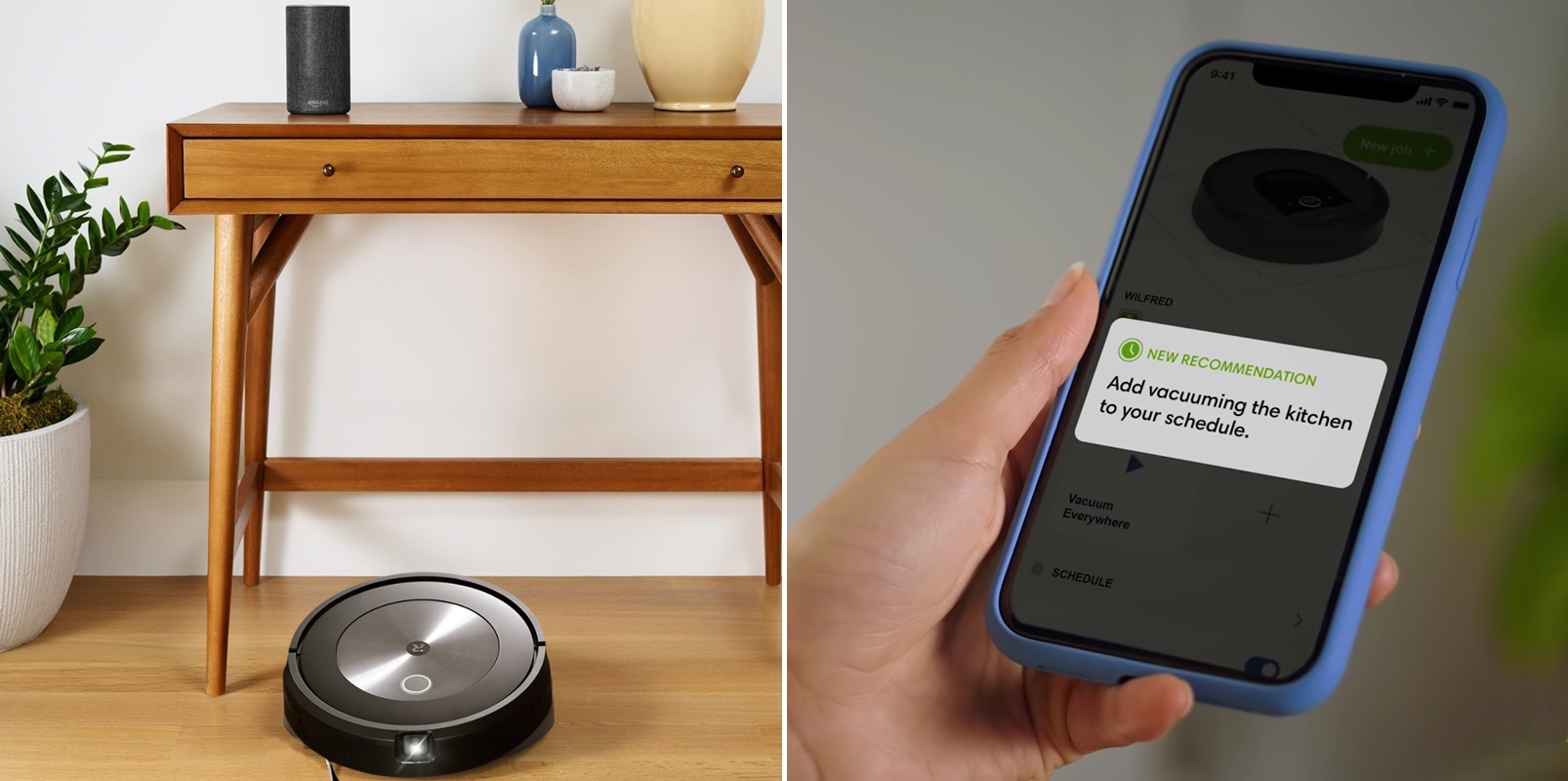
The iRobot app gives you a lot of control over your robot vacuum. You can customize features to your liking, set cleaning schedules, access and customize saved maps, and more. You can draw clean zones and keep out zones on the saved maps to customize the way you want the Roomba to clean.
They are also both compatible with Google Assistant, Amazon Alexa, and Siri. You can use these digital assistants to send voice commands to your robot vacuum.
Your phone and robot vacuum should both be connected to the wifi for the app and voice commands feature to work.
It is possible to run the Roomba without wifi. You are able to start and stop cleaning sessions by using the buttons on the vacuum itself. You just won’t be able to access or activate other features without wifi.
Similarity 6: Both have “keep out zones” and “select room cleaning”.
You can use features such as the clean zones and keep out zones to tell the Roomba what you want it to clean.
If you want it to avoid a certain spot, use a saved map on the app and draw a “keep out zone” over that area. Your Roomba will know to avoid that area when it cleans.
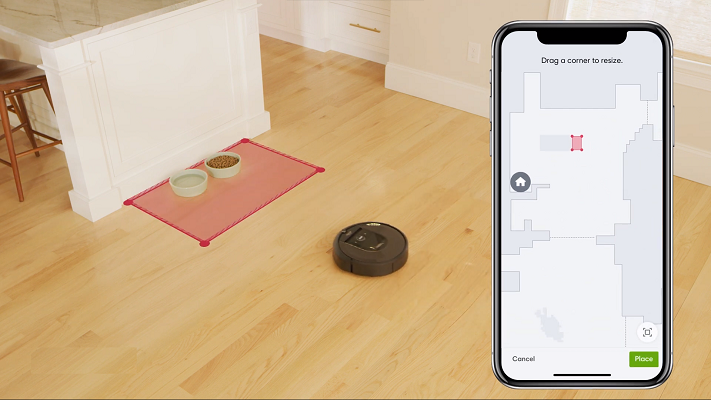
If you want it to clean only a specified area, draw a “clean zone” over that area. Your Roomba will start a cleaning session focusing only on what you drew.
You can also direct it to clean certain rooms only. This feature comes in handy when you use it with voice assistants. “Alexa, tell Roomba to clean the living room”. It feels like magic.
Similarity 7: Both are equipped with dual rubber rollers.
Unlike most robot vacuums on the market, Roombas are equipped with two rubber brushes instead of one.
The dual rubber brush system has two good things going for it.
The first is that both brushes are bristle-free and therefore easier to clean than bristle brushes.
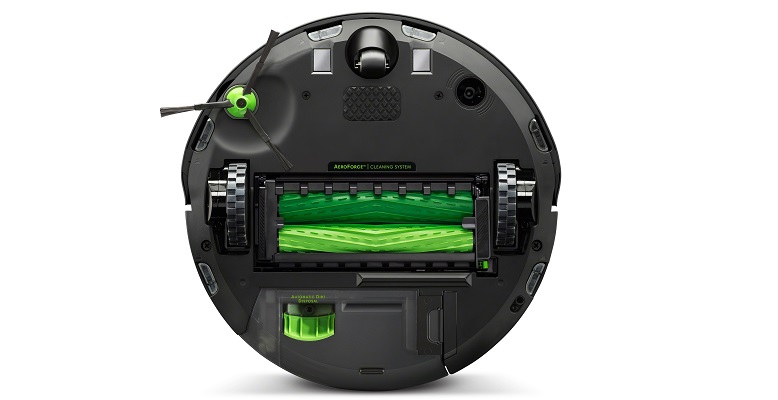
With conventional brush rollers, hair will inevitably get tangled in bristled rollers, and they can be quite difficult to detangle and take off.
That’s not the case with the j7 and j7+. Hair rarely wraps around rollers, and even when they do, they tend to get pushed toward the ends. After a couple cleaning sessions, you can take out the brushes and simply pull off the hair they’ve accumulated. The rollers are very easy to remove.
The second advantage is a deeper clean: one brush is meant to loosen up dirt, while the other is meant to sweep dirt up into the vacuum’s intake. This system works especially well on carpets because the first brush can make it easier to remove dirt from the carpet fibers.
Similarity 8: Both have geofencing so they can clean when you are not around.
If you don’t want to be at home when your robot vacuum starts a cleaning session, you can take advantage of the geofencing feature. Using your phone’s location, the iRobot app will tell the Roomba to start cleaning when you leave your home.
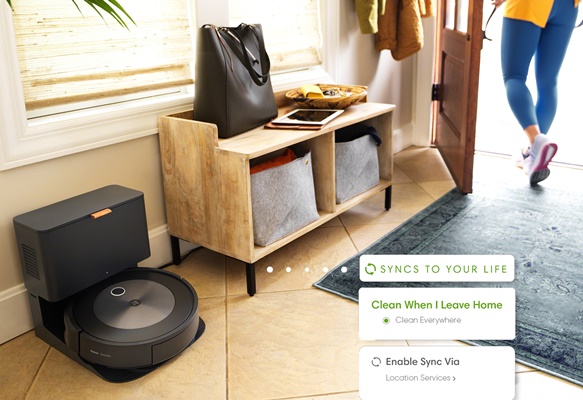
The app can also work in conjunction with other smart devices in your home, such as a smart garage door opener. When the app detects that the garage door has opened, it can take this as a sign that you’ve left for the day. It will then send a command to the robot vacuum to start cleaning.
With this feature, you don’t need to set a cleaning schedule. You’ll just come home to clean floors without much input from you. This can also work well if you don’t want to be around when your robot vacuum is running, but your schedule is irregular and changes frequently.
FAQs
What year did the Roomba j7 come out?
iRobot launched the Roomba j7 and j7+ in September 2021. These models also introduced iRobot’s PrecisionVision navigation technology.
How long does the Roomba j7 last?
The j7 can last about 85 minutes on a single charge. However, it can automatically recharge as many times as necessary to complete a cleaning session.
Does the Roomba j7+ have mopping?
No, the Roomba j7+ can only vacuum floors. However, it’s compatible with the Braava jet m6 Robot Mop, which can team up with Roomba robot vacuums to mop floors.
Is the Roomba j7+ good for pet hair?
Yes. The j7+ can easily pick up pet hair from different kinds of bare floors as well as carpets.
Can the Roomba j7+ clean multiple floors?
Yes. However, the j7+ won’t be able to climb stairs by itself, so you’ll have to carry it to a different floor each time. You can also purchase a dock for each floor so your robot vacuum will be able to recharge whenever necessary.
So, Which One Should You Choose?
The only difference between the j7 and the j7+ is that the j7 is bundled with the Clean Base. Other than that, the j7 and j7+ are identical and therefore have the exact same features.
Even if you purchase the j7 robot vacuum by itself, it’s still compatible with the Clean Base. You can purchase the Clean Base separately if you decide you want one at a later date.
Deciding on which one to get comes down to this: if you don’t mind emptying the dustbin manually after each cleaning session, go with the j7. If you don’t want the hassle, the j7+ is for you.
Or click here to see the Roomba j7+ on Amazon.
